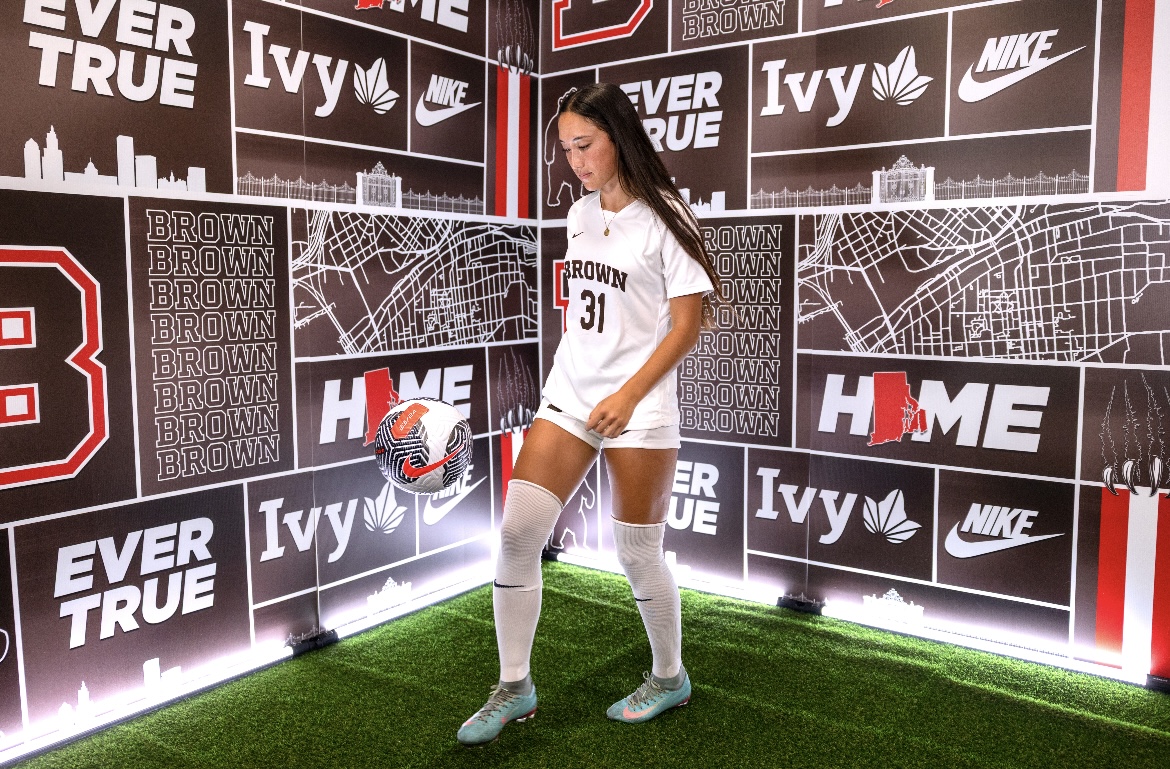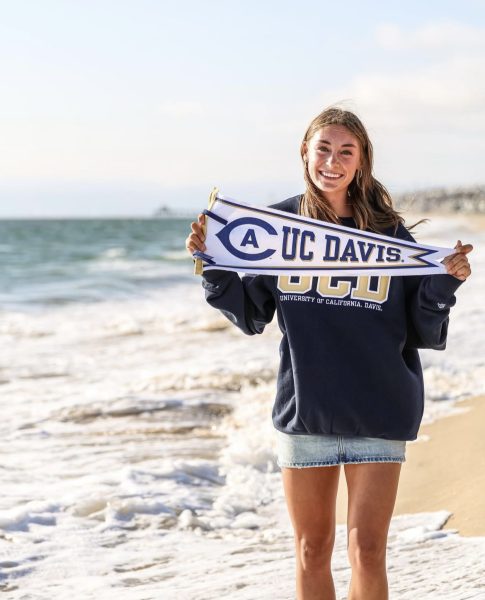
Nami Walsh (11) juggles a soccer ball in her new Brown University uniform at a media shoot. Walsh verbally committed to play Div. I soccer on August 11th, 2025. Photo courtesy of Nami Walsh.
Many Falcons spent this past summer relaxing, with carefree beach days and sleeping late into the day. However, for a handful of student athletes, the word “carefree” could not have been further from reality, as these months were some of the most crucial and stressful times of their lives: attempting to take their sport to the next level as a Division I Athlete.
Collegiate-aiming student athletes experience a grueling sophomore year dedicated to reaching their goal, ending with weeks of summer spent waiting for the confirmation that their efforts paid off. June 15, after sophomore year, is the first day of many that athletes can legally hear back from college coaches with offers. Throughout high school, athletes work tirelessly, reaching out to colleges, attending college camps, and, of course, training every day on the court, field or pool to sharpen their skills. They elevate their game where regimen is strict and a competitive mindset is the key to success.
Nami Walsh (11), who verbally committed to play Div. I soccer at Brown University this past summer, is one athlete who tackled this journey.
“I started [soccer] when I was maybe 5 or 6 [years old],” Walsh said. “I think you start getting the idea of college in your head at, like, seventh or eighth grade at least, and then you start emailing them and maybe doing Identification Camps (ID) a year or less before June 15.”
Like Walsh, a lot of athletes go to ID Camps hosted by colleges to scout and evaluate athletes for potential recruitment.
Additionally, athletes take part in the emailing process, which begins with athletes researching schools that align with their academic and athletic pursuits. The next step is to reach out to coaches of the athlete’s intended schools. Students express interest in the school and its team by detailing their own academic or athletic statistics, before ending the email with a follow-up plan or action item.
“The only time I felt super nervous was when I knew a college was coming to watch specifically me,” Walsh said. “Most of the time when I was going into [soccer] showcases, my mentality was that it doesn’t matter how many mistakes you make if you have a good work ethic, and try to get on the ball as many times to increase the chance of doing something impressive. Nerves are always going to be a problem, but you can convert that into excitement, put your mind off it and talk to your teammates.”

Colleges seek out the best of the best — players who are going to add to their team. Recruitment is not like high school athletics, where one only needs to have‘good enough’ skills to make a team.
The school’s football Offensive Line Coach, Jake Ashby, watches and guides many student athletes through the recruitment process. Ashby has experience recognizing athletes who are capable of making the difference college coaches look for.
“As somebody who played collegiate sports, it becomes more of a job than playing high school sports with your friends,” Ashby said. “The qualities are someone who’s driven, loves the sport, has the passion for the sport and wants to continue to get better and refine their craft.”
Colleges require athletes with the whole package of being regimented, talented and competitive. These athletes don’t complain or give anything less than 100% in practice because they see every playing session as an opportunity to get better.
Wanting to play a collegiate sport becomes athletes’ consuming focus from an early age. What was once just a hobby, can give way to a lifestyle defined by one’s sport.
The glory and success of committing to play the highest level of a sport in college often shroud the sacrifices and risks these athletes take. People don’t see the rejection, pain and self doubt the athletes experience after pouring so much into their sport. Practices going late into the night or games every weekend often jeopardize other endeavors, schoolwork or their social life. It’s also a risk to rely on one’s physical excellence when injuries are so common, especially for athletes who practice every day.
This all comes out to one apparent certitude: these athletes want to play at the next level more than anything. These athletes prioritize playing at the next level over having a large pool of colleges applications. They trade the burden of seemingly endless college applications for another; seemingly endless time spent “perfecting” their athletic skills and catching the eye of college scouts. To some, this might seem like a gamble, but for these athletes, the hard work and risk is well worth the reward.
Kelly Randolph (11) started beach volleyball just one year before committing to play Div. I at the University of California, Davis, demonstrating her dedication during the 2024-25 school year. While the foundation of seven years of indoor volleyball helped Randolph, the two variations of volleyball have significant differences, proving how much hard work and drive must have factored into her recruiting journey.
“I knew all along that I really wanted to be part of a college-level sport,” Randolph said. “[Committing] obviously takes a lot of stress off of junior and senior year, but [I] honestly just fell in love with UC Davis. I loved the coaches, the campus and the program sounded amazing, so I just knew that something better wasn’t going to come along.”
Loving the school you have an offer from certainly gives athletes confidence in their choice in recruiting early, but there are some cases where waiting is beneficial.
“There are a lot of [athletes] that are well known because they’re good from a young age,” Walsh said. “I was not very well known so I think the only negative is: there might have been more options to come if I had waited. But then, I probably would’ve lost Brown.”
Waiting to accept offers gives colleges more time to explore other possible recruits, who could replace waiting individuals, and shows the colleges that they are not an athlete’s first choice. Colleges appreciate mutual interest between the coaches and the players.
“One really big benefit for me was [that] I didn’t want to go back to school and have to focus on building up college applications and have multiple things going on at once,” Walsh said. Now I just have to focus on maintaining soccer but also trying to get as good grades as possible. And I like to enjoy high school; I love playing on the school team.”
Walsh and Randolph are exceptional — it is still the beginning of the recruiting process for the class of 2027. Many expect athletes to commit right after June 15, but this is a misconception. In reality, anything during the summer after turning 16-years-old is an early end for the process. Although Walsh and Randolph started gaining momentum with their recruiting process a year to six months before June 15, football athletes’ timelines may look a little different.
“[Recruitment] really starts as soon as they start getting varsity film,” Ashby said. “We’ll encourage our athletes to create their own personal highlights and [they’re] able to start to send [them] out to coaches. The athletes themselves say they want to play in college and once they say that, they’re on our recruiting list. From that list, we’ll pull people out of class to come talk to the coaches. The biggest thing that our athletes can do is be proactive and we’re there as coaches to support that proactivity.”
Since club football is not as influential as club soccer or club beach volleyball, high school football coaches are most involved in their players’ recruiting processes. In other sports, club coaches are more integrated into the procedure, along with family and friends who offer support.
“My brother kind of paved the way,” Walsh said. “He also committed for soccer, and he was always there for me mentally because he knew what it was like, and he was the only person who wasn’t pushing me. Having him be there was super great.”
With only roughly 7.5% of high school athletes making it to the collegiate level, anyone who can relate to the pressure is an incredible resource during this extensive process.
“I would say my biggest supporters are my family and friends,” Randolph said. “Talking to them throughout the whole process was amazing, especially talking to friends who are also going through the recruiting process. My coaches at Wave Volleyball Club have just been so helpful. I was able to ask them any questions I needed on and off the court, with emailing and coordinating tasks, but then also with improving my level of play.”
Randolph was working toward this shared goal alongside people she had grown up playing indoor volleyball with. The camaraderie proved to be helpful as four other female athletes from the Class of 2027 committed to play Div. I volleyball over this past summer. Emery Gonzales (11) committed to play at Santa Clara University, Jaycee Mack (11) committed to play at Baylor University, Lila Green (11) committed to play at the University of Kansas and Lilia Decker (11) committed to play at Loyola University, Chicago. All the stress and hardship were easily overpowered by the ecstaticity of finding out the life-changing news.
The very moment when Walsh was at Brown, she was “having lunch with the coaches and they said ‘we have an offer for you’,” Walsh said. “I was obviously really excited and after I let it sink in, I was definitely very relieved. I also felt accomplished because this is everything that my life has led up to; I’ve done everything in my power for this moment.”
Every athlete’s journey started the same way, whether it was bumping their first volleyball or scoring their first goal. A spark ignited, and from there on, these college commits spent countless days laboring in all conditions to strengthen their skills. Reaching the achievement of recruitment was never the final goal for these student athletes; it is just the beginning as they will now go on to compete among the best of the best.
“[My] biggest advice [is that] the process is going to be long; enjoy it,” Walsh said. “Just the idea of having college coaches talking to you is a good accomplishment, no matter who it is. It’s cool to have that opportunity and I think it’s important to be positive through it all. It’s a downward spiral if you get yourself negative and if you focus on college coaches not emailing back yet. It’s going to work itself out.”